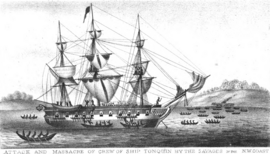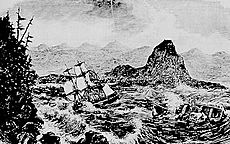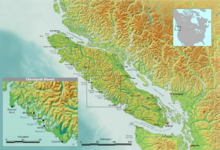Tonquin (1807 ship) facts for kids

Tonquin being boarded by Tla-o-qui-aht
|
|
Quick facts for kids History |
|
|---|---|
| Owner | Edmund Fanning |
| Operator | Edmund Fanning |
| Builder | Adam and Noah Brown |
| Laid down | 1 March 1807 |
| Launched | 26 May 1807 |
| Acquired | 1807 |
| Fate | Sold to the Pacific Fur Company |
| Owner | John Jacob Astor |
| Operator | Jonathan Thorn |
| Acquired | 23 August 1810 |
| Fate | Blown up 16 June 1811 at Clayoquot Sound, Vancouver Island |
| Sunk: | 1811 |
| General characteristics | |
| Type | Bark |
| Tonnage | 269 or 290 BOM |
| Length | 96 ft (29 m) |
| Propulsion | Sail, three-masted |
| Armament | 10 guns, fitted for 22 |
The Tonquin was an American merchant ship. It weighed about 290 tons. First, it was used by a company called Fanning & Coles. Later, it was sold to the Pacific Fur Company (PFC). This company was part of the American Fur Company.
In 1807, its first captain, Edmund Fanning, sailed the Tonquin to China. They went there to get valuable Chinese goods for trade. The ship was then prepared for another trip to China. But instead, it was sold to a German-American businessman named John Jacob Astor. Astor had big plans to control the fur trade in North America. He wanted the Tonquin to set up and supply trading posts on the Pacific Northwest coast. Furs bought or trapped there would then be sent to China. People in China really wanted certain animal furs.
The Tonquin left New York City in late 1810. Its goal was to reach the Columbia River. The ship sailed across the Atlantic Ocean. In December, it arrived at the Falkland Islands. Captain Jonathan Thorn left eight PFC employees there. But other men on the ship threatened Thorn. So, he had to go back and pick them up the same day.
After sailing around Cape Horn into the Pacific Ocean, the Tonquin visited the Kingdom of Hawaii in February 1811. They bought much-needed fresh food and animal products. They also hired 24 Native Hawaiian workers, called Kanakas. This happened after talks with Kamehameha I and Kalanimoku. Finally, the Tonquin reached the Columbia River on March 22, 1811. In the days that followed, eight men died trying to find a safe path over the Columbia Bar.
In May 1811, work started on the only trading post the Tonquin helped create. It was called Fort Astoria. It was built on the coast of what is now Oregon. After the fort was built, the ship left. It carried most of the trade goods and supplies from the fort. The plan was to trade these items with Native American tribes on the coast of Vancouver Island.
In June, the crew began trading with the Tla-o-qui-aht people at Clayoquot Sound. A disagreement started because Captain Thorn treated an elder badly. All but four crew members were killed by armed Tla-o-qui-aht warriors. These warriors were led by Chief Wickaninnish. The remaining survivors then blew up the ship's powder room on purpose. This destroyed and sank the Tonquin. Joseachal, an interpreter from the Quinault tribe, was the only crew member to survive. He returned to Fort Astoria. There, he told Duncan McDougall what happened. His story is the only detailed report of how the Tonquin was destroyed.
Contents
Early Voyages of the Tonquin
The Tonquin had an interesting start before its final, famous voyage. It was built for trade and traveled far across the oceans.
Building the Ship
The Tonquin was built in 1807. It was made by Adam and Noah Brown. Their shipyard was in New York City.
First Trip to China
The company Fanning & Coles first bought the Tonquin. They wanted it for the Old China Trade. The ship had a crew of 24 people, including Captain Edmund Fanning. It left New York City on May 26, 1807. Its destination was the port of Guangzhou in China.
On its way, the Tonquin survived a strong typhoon. This happened while crossing the Macclesfield Bank. The ship then passed the Wanshan Archipelago to reach Guangzhou. Before returning to the United States, the Tonquin was stopped by a British officer, Commodore Edward Pellew. Captain Fanning knew Pellew. After a talk, Fanning was allowed to start his journey home. He left the port on November 18, 1807.
Another ship from Fanning & Coles, the Hope, was nearby. Fanning met its captain, Reuben Brumley. Then, Fanning continued sailing towards the Bocca Tigris. British ships there stopped the Tonquin for a day. The next day, orders from Commodore Pellew arrived. They said the Tonquin should be freed right away. Pellew also sent his apologies. Fanning returned to New York City on March 6, 1808. He brought a full load of valuable Chinese goods.
Second Trip for Sandalwood
In 1808, the Tonquin began its second major trip. This journey focused on the sandalwood trade in the Pacific Ocean. The year before, Captain Brumley of the Hope had made a deal with people on Fiji. They agreed to cut and collect sandalwood trees. Brumley would return in 18 months.
The Embargo Act of 1807 was a problem for this trip. This law stopped American ships from trading overseas. So, Coles and Fanning went to Washington, D.C.. They asked the government for permission to go to Fiji. They met with Albert Gallatin, who was the Secretary of the Treasury. Gallatin sent their request to President Thomas Jefferson. President Jefferson officially approved the trip.
The Tonquin sailed for Fiji on June 15, 1808. Brumley was the captain. Both Coles and Fanning were also on board. From New York City, the ship sailed south through the Atlantic Ocean. It passed parts of the Brazilian coast and Gough Island. After going around Cape Horn, the ship sailed west. It landed at King George Sound in modern Western Australia on October 8, 1808.
A tent was set up for crew members who had scurvy. This allowed them to get better. Local Noongar groups often visited the Americans. They would show they were peaceful by putting down their weapons. Only after the Americans put down their guns would trading begin. Americans traded things like beads, metal buttons, and knives. In return, they received Noongar stone tools and food. The sick crew members got well in a few days. The Tonquin left the sound on October 21. It sailed to Tongatapu. There, local people sold the crew lots of "hogs, bread-fruit, [and] yams."
On December 10, the Tonquin passed Vatoa. It landed at Vanua Levu the next day. A group of iTaukei men greeted them with gifts of fruit. The Americans told them about the sandalwood agreement. The local leaders soon left to spread the news. The next day, iTaukei men brought fresh coconuts, breadfruit, hogs, and yams in their canoes. The local leader, Tynahoa, arrived. He said he had the agreed amount of sandalwood ready.
The Americans and Tynahoa talked on the Tonquin for an hour. He told them that British ships from Port Jackson had visited. These ships were still anchored nearby. But Tynahoa insisted that no sandalwood had been sold to them. He had put a tabu (a sacred ban) on selling sandalwood.
The sandalwood was slowly brought to the Tonquin. This took several months. But it was worth the wait. Fanning later said the ship's entire hull and part of the deck were filled. Tynahoa then officially lifted the tabu. This allowed the British merchants to finally buy their sandalwood. The Tonquin left for Guangzhou on March 22, 1809. It sailed northwest from Vanua Levu. They saw islands in modern Vanuatu and the Solomon Islands. They also saw parts of the Federated States of Micronesia, like Kapingamarangi. After reaching Guangzhou, the sandalwood was sold. In return, they bought various Chinese products. The Tonquin safely returned to New York City.
The Pacific Fur Company's Plans
The Tonquin was sold to John Jacob Astor on August 23, 1810. He paid $37,860 for it. Astor bought the ship for his big plan. He wanted to get involved in the maritime fur trade on the Pacific Northwest Coast of North America. The Tonquin was given to the Pacific Fur Company (PFC) to help with this goal. The PFC was a new company mostly funded by Astor's first fur business, the American Fur Company. Astor hired United States Navy lieutenant Jonathan Thorn to command the ship. The Tonquin had 10 guns.
Journey Across the Atlantic
On September 8, 1810, the Tonquin left New York harbor. It was headed for the Columbia River in the Pacific Northwest. The ship carried many items. These included fur trade goods, seeds, building materials for a trading post, tools, and parts for a small schooner. This schooner would be used for coastal trade. The crew had 34 people, including the captain. Thirty of them were British. Four company partners were on board: Duncan McDougall, David and Robert Stuart, and Alexander McKay. There were also 12 clerks and 13 Canadian voyageurs. Four skilled workers were also present: a blacksmith, a carpenter, a boat builder, and a cooper.
After leaving the United States, the Tonquin sailed southeast into the Atlantic. On October 5, the ship saw Boa Vista in the Cape Verde Islands. Captain Thorn was worried about British ships. The British often forced sailors into their navy. So, he decided not to stop at the islands. After sailing down the coast of West Africa, the Tonquin headed for South America. Off the coast of Argentina, a strong storm hit. Many sails were ruined, and the ship got two new leaks. As the trip continued, fresh water supplies became very low. Each sailor got only three gills of water a day.
The ship landed at the Falkland Islands on December 4. They needed to make repairs and get more water. They found a good water source at Port Egmont. Captain Thorn set sail on December 11. He left eight men behind. These men included partner David Stuart, Gabriel Franchère, and Alexander Ross. The eight men only had a rowboat. They rowed for over six hours to catch up with the Tonquin. Robert Stuart quickly threatened Thorn. He said, "You are a dead man this instant" if Thorn did not stop the ship. This made Thorn order the crew to go back and pick up the stranded men.
Thorn's actions caused more problems between him and the Pacific Fur Company employees. The company workers stopped speaking English to keep the captain out of their talks. The partners spoke in their old language, Scottish Gaelic. The hired PFC workers used Canadian French. Thorn was very annoyed by "their jokes and chanting their outlandish songs." On December 25, the Tonquin safely sailed around Cape Horn. It then headed north into the Pacific Ocean.
Across the Pacific Ocean
The Tonquin reached the Kingdom of Hawaii on February 12, 1811. It dropped anchor at Kealakekua Bay. There was a big worry that men would leave the ship to stay on the islands. Thorn had to make up with the PFC partners to keep the crew in line. Several men did try to leave. But with help from the nearby Native Hawaiians, they were brought back. One man was whipped, and another was put in chains. Thorn gathered everyone and told them to stay on the ship.
Trading with the Hawaiians began. The crew bought cabbage, sugar cane, purple yams, taro, coconuts, watermelon, breadfruit, hogs, goats, two sheep, and chickens. They traded "glass beads, iron rings, needles, [and] cotton cloth" for these items. A message from government agent John Young told the Tonquin to visit him for meat. Then, they were to meet King Kamehameha I on Oʻahu.
When they entered Honolulu, the crew met Francisco de Paula Marín and Isaac Davis. Marín helped as an interpreter. He helped with talks between King Kamehameha I and Kalanimoku, an important Hawaiian official. Marín also guided the ship into port. For this, he received five Spanish dollars. Twenty-four Hawaiian kanakas were hired for three years. Half would work in the fur trade. The other half would be laborers on the Tonquin. One Hawaiian, Naukane, was chosen by Kamehameha I to look after these workers. Naukane was called John Coxe on the Tonquin. He later joined the North West Company. The Tonquin and its crew left the Hawaiian Kingdom on March 1, 1811.
The Columbia River was reached on March 22, 1811. But its dangerous bar was a big problem. Thorn sent five men in a boat to find the channel. But the rough waves flipped the boat, and the crew was lost. Two days later, another small boat also sank. Of those five crew members, which included two Hawaiian Kanakas, only an American and a Hawaiian survived. In total, eight men died trying to find a safe way past the Columbia Bar.
Finally, on March 24, the Tonquin crossed into the Columbia's estuary. It anchored in Baker Bay. The people then went fifteen miles up the river to what is now Astoria, Oregon. They spent two months building Fort Astoria. Some trade goods and other supplies were moved to the new trading post. During this work, small trades happened with curious Chinookan Clatsop people.
The Ship's Destruction
On June 5, 1811, the Tonquin left Baker's Bay. It had a crew of 24. The ship sailed north to Vancouver Island. Its goal was to trade with different Nuu-chah-nulth people living on the island's west coast. Alexander McKay was on board as the supercargo (in charge of the cargo). James Lewis was a clerk. Near Destruction Island, a man from the Quinault nation, Joseachal, was hired by Thorn to be an interpreter. He was recorded as "Joseachal" in company records. His sister was married to a Tla-o-qui-aht man. This connection may have helped him survive later on Vancouver Island.
While anchored at Clayoquot Sound, the Tonquin crew traded furs with the Native people. Many members of the nearby Tla-o-qui-aht nation came onto the ship to trade. An experienced elder named Nookamis and Captain Thorn discussed the trade. Thorn offered a trade rate that the elder did not like. Nookamis wanted five blankets for every fur skin. These talks continued all day. Thorn became more and more frustrated that the Native people would not accept his terms. The interpreter later told McDougall that Thorn "got in a passion with Nookamis." Thorn took one of Nookamis's fur skins and hit him in the face with it. After this outburst, Thorn ordered the ship to get ready to leave. The Tla-o-qui-aht people were still on board.
The Tla-o-qui-aht talked among themselves. On June 15, as the Tonquin was about to leave, they offered to trade their furs again. They suggested that for one skin, the PFC officers should sell three blankets and a knife. McDougall said that "A brisk trade was carried on till all the Indians setting round on the decks of the Ship were supplied with a knife a piece."
Suddenly, violence broke out. Warriors led by Wickaninnish attacked the crew on board. All but four men were killed. Three crew members escaped in a rowboat during the chaos. One badly wounded man, James Lewis, was left on the ship. The next day, June 16, Lewis reportedly blew up the Tonquin. He lit a fuse that set off the ship's powder magazine. This happened when the Tla-o-qui-aht returned to take things from the ship. The explosion may have killed more than 100 Native people. The crew members who had escaped were later captured and killed by the Tla-o-qui-aht after the explosion.
The only known survivor of the crew was Joseachal. He returned to Fort Astoria with help from a noble Lower Chinookan leader named Comcomly. Joseachal's story is the only one that tells what happened to the Tonquin.
Ship's Legacy
Some places are named after the Tonquin. These include Tonquin Beach in Tofino, BC, Tonquin Valley, and Tonquin Pass. In 2008, a movie was being planned. It would show the events that led to the Tonquin's destruction in 1811.
See also
- John R. Jewitt, whose ship Boston was similarly captured nearby



